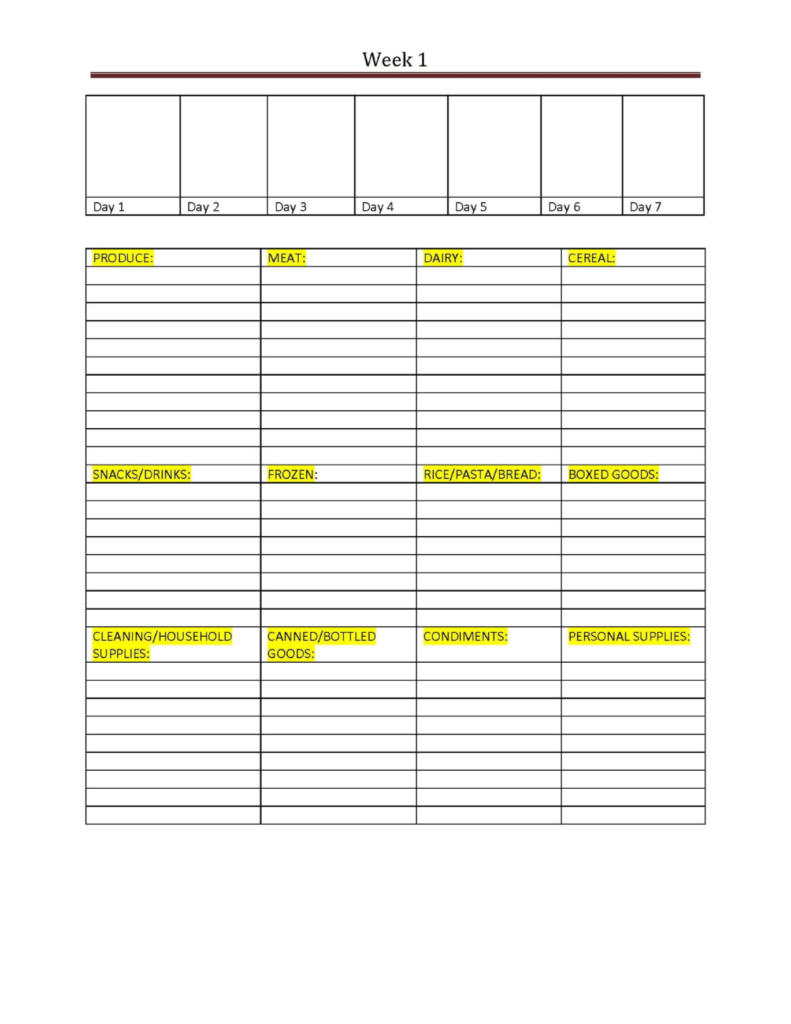Meal Planning 101 (or in other words What’s For Dinner?)

 Is it really time for school to start? I’ve already begun to see yellow school buses canvasing my neighborhood and kids scampering across sidewalks carrying heavy book bags. It sneaked up on me pretty fast this year because it’s still 90 degrees and the sun isn’t setting until after 9pm here in Boise, Idaho. But alas the time has come for all good boys and girls to go back to school.
Is it really time for school to start? I’ve already begun to see yellow school buses canvasing my neighborhood and kids scampering across sidewalks carrying heavy book bags. It sneaked up on me pretty fast this year because it’s still 90 degrees and the sun isn’t setting until after 9pm here in Boise, Idaho. But alas the time has come for all good boys and girls to go back to school.
 This is a historic year for me. With the graduation of our youngest child Abby, I’ve become an empty-nester and so for the first time in 32 years I will not be taking first day of school pictures in front of the house nor telling my kiddos to make it a great day. I’ll be watching from the sidewalk as other parents drop their kids off for another exciting new school year. I’m feeling pretty sorry for myself . . . BooHoo!
This is a historic year for me. With the graduation of our youngest child Abby, I’ve become an empty-nester and so for the first time in 32 years I will not be taking first day of school pictures in front of the house nor telling my kiddos to make it a great day. I’ll be watching from the sidewalk as other parents drop their kids off for another exciting new school year. I’m feeling pretty sorry for myself . . . BooHoo!
The Power of The Dinner Hour
 For a lot of parents back to school means a little more time during the day to workout more, keep the house cleaner and actually keep up with the laundry. It also may mean more structure for kids as after school activities ramp up with their accompanying car pool duties and dinner-interrupting practice hours. This can wreak havoc on family dinner time. Studies show that families which keep a pretty steady dinner hour where they sit down and discuss the day together over a meal actually raise less troubled kids. And the meal doesn’t have to be very fancy!
For a lot of parents back to school means a little more time during the day to workout more, keep the house cleaner and actually keep up with the laundry. It also may mean more structure for kids as after school activities ramp up with their accompanying car pool duties and dinner-interrupting practice hours. This can wreak havoc on family dinner time. Studies show that families which keep a pretty steady dinner hour where they sit down and discuss the day together over a meal actually raise less troubled kids. And the meal doesn’t have to be very fancy!
A Washington Post article written in 2015 by a Harvard medical school professor identified multiple benefits to eating family dinner together in a positive environment:
- Improves vocabularies
- Predicts outstanding academic performance
- Improves nutrition and subsequent healthy body weight
- Lowers risk of obesity
- Deters high-risk teen behaviors like smoking, marijuana use, eating disorders and sexual activity
- Improves relationship with parents
How can you make this happen in your home? I’m here to tell you that it’s not easy nor is it going to be perfect. Sports (practices and games) found their way into my family dinner hour way too often, but we made it work as frequently as we could. I’d take a bet that my kids consider dinner time a part of the best memories growing up because we made the time to be together.
Meal Planning 101
For me it starts with good meal planning. I’m presenting a few ideas to help you get through this school year with your head held high as you fiercely protect your family dinner hour. Just do the best you can so that when your kids ask “What’s For Dinner?”, you’ve got it covered.
Step 1: Plan ahead/Meal Planning Sheet
Choose a day to do your grocery shopping. The day before you go grocery shopping, sit down and map out a simple meal plan for the week. We’re just going to focus on dinner.

Chunky Beef and Bean Chili

Classic Spaghetti and Meatballs
Choose a couple of dishes you know your family likes. Then take the main ingredient in those dishes and find two new recipes that you’d like to try. Let’s use my blog recipes for example and say your family loves Classic Spaghetti with Meatballs. Take the beef from the spaghetti dish and find a recipe that uses beef, say Chunky Beef and Bean Chili.

Lemon Basil Chicken over Whole Wheat Penne Pasta

Asian Chicken Vegetable Stir-Fry
Do the same for the second dish. How about Asian Chicken and Vegetable Stir Fry? Take the chicken from that dish and try something new like Lemon Basil Chicken over Whole Wheat Penne Pasta.
Now you have four dishes.
Place these four recipes on a Meal Planning Sheet which looks something like the sheet below which has the days of the week across the top and categories of ingredients listed in columns that may or may not correspond with the aisles of your favorite grocery store (super-handy if it does!) Then fill in the other three days of the week with three other really simple meal ideas that might include a dinner out, a pizza dinner (either homemade or take-out), a fend-for-yourself dinner, a “breakfast food” dinner, a leftover dinner or some other fairly simple meal. Now you have seven dinner meals for the week. This is an amazingly good start. Well done.

Step 2: Deconstruct your recipes

Deconstructing your recipes is often the fun part. This is where you take your recipe apart, ingredient by ingredient and place each ingredient in a category on your Meal Planning Sheet. Let me get you started: for the Spaghetti and Meatballs you’ll place the beef under Meat, the pasta under Rice/Pasta/Bread, the spaghetti sauce under Canned/Bottled Goods and continue on for each ingredient in your recipe. Then repeat for the other recipes, adding x2 if you’re repeating an ingredient like your main ingredient. If you already have that ingredient in your pantry, don’t list it. As you continue to make many of the same recipes each month you’ll collect spices and sauces so that you won’t have to buy all of the ingredients each time you shop thus saving you a lot of money. Obviously for your take out or dining out dinners you won’t have to list anything . . . Sweet!
Step 3: Fill in the Nutritional Puzzle

Chicken Quesadillas with White Bean Salsa
Eating healthfully, economically and quickly are goals for most families. Hopefully you’ve found a good balance of all three of these goals in your selection of recipes. For your health goal I’d like you to take a look at your recipe choices. Are they all-in-one type main dishes which provide many of your food groups in one dish? Or do you need to add an item or two to make them more complete. If so, list these items under your recipes on your Meal Planning Sheet and add the ingredients in the category lists so you have what you need. It might be as simple as bagged salad or cut-up fruit or whole grain bread.
What is a complete meal? A complete meal includes certain components which when combined together provide the nutritional needs necessary for good health. Here are important components of a complete meal:
- Lean protein like fish, chicken, beef, turkey or eggs, beans, low-fat cheese or yogurt
- Colorful vegetables and/or fruits (choose a variety over the course of a week)
- Whole grains like quinoa, brown rice, whole grain pasta and/or bread
- Heart-healthy fats like olive oil, nut oils, nuts, seeds, avocado or nut butters
Here on the blog, I’ve created recipes that are all-in-one meals you might want to try:
Cauliflower Rice, Chicken and Sausage Italian Bake



Roasted Vegetables and Feta Quinoa Bowl


Baja Fish Tacos with Mango Salsa

Spicy Turkey Meatloaf with Yukon Gold Roasted Potatoes

Step 4: Follow Through

Step 4 might be the hardest to do. All the planning in the world won’t make up for a lack of implementation. Try these tips:
- To help you succeed, keep your recipes in a binder along with copies of your Meal Planning Sheets. Don’t try to do too many weeks before you repeat. I know of some families on just a 3 week rotation and others on a 12 week rotation. Make it work for you. I enjoy cooking so many different dishes that I’m not sure any one week is the same in our house. However, when the kids were little, I repeated many of the same recipes, even if it was just for my sanity and because I knew the family was happy with the dishes I prepared.
- Enjoy the feeling of being organized. Organization will not only save you money but will save your sanity. Knowing what’s for dinner ahead of time will make all the difference.
- Start fixing your meal before the kids come home from school. I know days get away from you, but if possible start prepping dinner before all h*** breaks loose after school. This one tip given to me from an experienced mother saved me a lot of headaches over the years.
- Don’t give in to fast food dinners too often. Fast food is so void of nutritional value, is full of sodium and calories, leaves kids wanting more, trains taste-buds to prefer high fat foods and is costly. This is a once-in-awhile treat.
Special Note: For picky eaters you may need to add more variety so as to introduce your picky eater to different tastes and textures. Picky eaters stay picky eaters if not given the opportunity to try new things. Our first and fifth children were the most picky. The first child quickly grew out of his “pickiness” as he experimented with new foods early on and by college he was eating a good variety of foods. Our fifth child on the other hand is learning hard lessons about being afraid to try new things, but now that she has started college she reports she is branching out more.
Happy Meal Planning!

